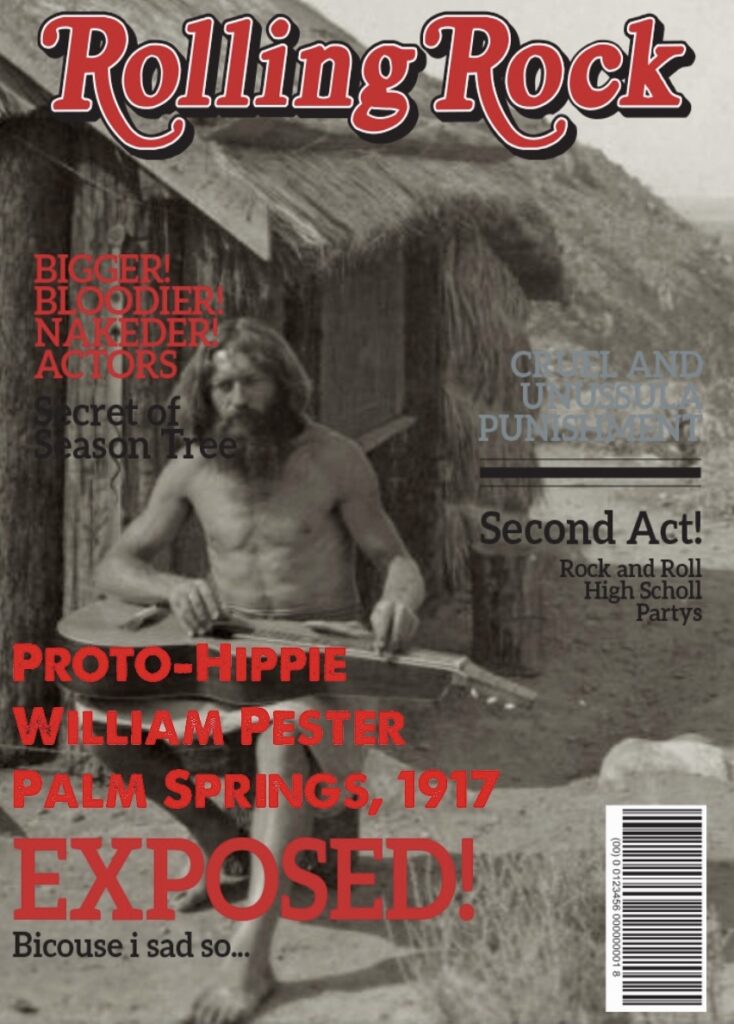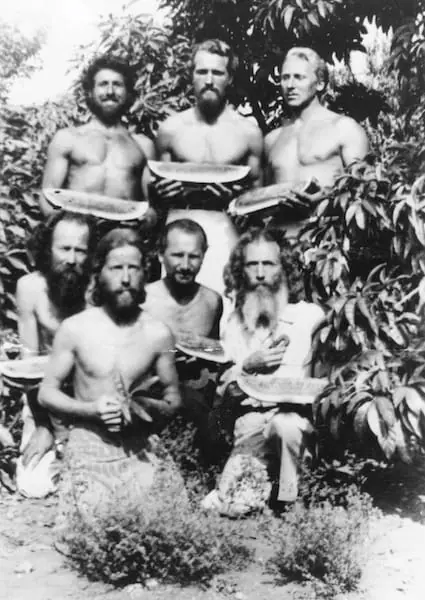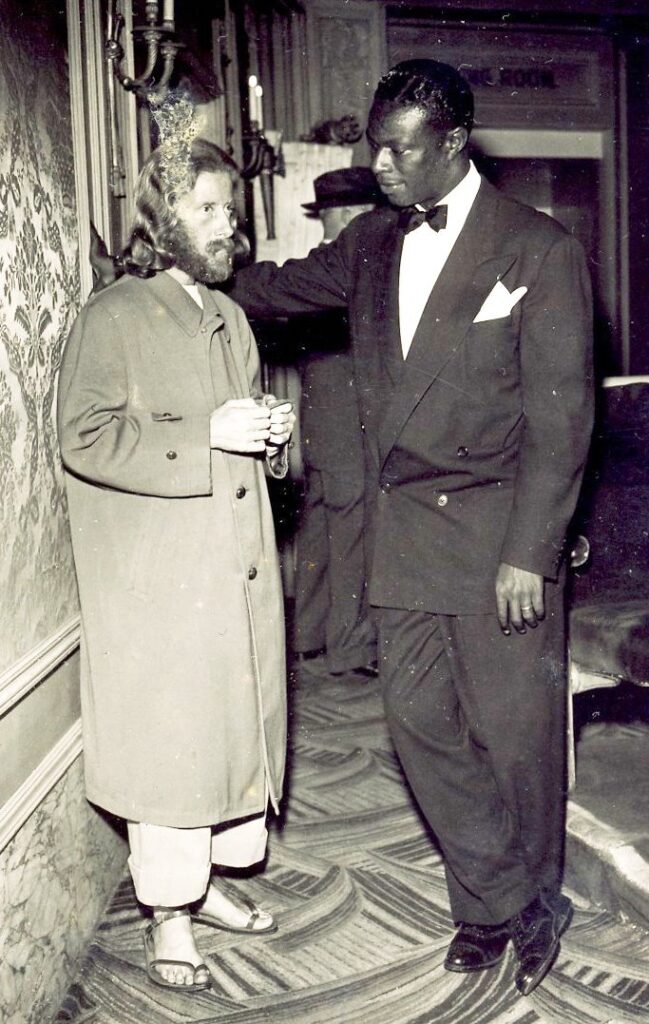
The Unlikely Story of William Pester, eden ahbez, and Gypsy Boots
In the early part of the 20th century, against the backdrop of a rapidly changing America, three mysterious, long haired, bearded proto-hippies eerily emerged out of the California desert, each heralding lifestyles embracing nature, art, and unconventional ways. Their stories feature interwoven tales of rebellion against societal norms, forging paths that would one day give birth to the feral flower children of the 1960s. William Pester, eden ahbez, and Gypsy Boots, three names that may not resonate in the larger historical narrative, in spite of the fact that each possessed a vital, transformative ethos that set the stage for the burgeoning hippie movement towards the end of the century.

1940s Nature Boys with Gypsy Boots (top left) and eden ahbez (bottom left)
Wandering Spirit: William Pester, the Hermit of Palm Springs
Born in the small town of Borna, Saxony, Germany, in 1885, William Frederick Pester was not destined for the average humdrum existence of his time. The son of a stonemason, Pester grappled with the loss of his mother and the looming shadow of military service before he set sail for America in search of freedom. His journey took him westward, where, as a young immigrant, he quickly became engrossed in the literary landscapes that depicted the romanticism of nature and the culture of native Americans. Pester’s life was one of exploration, markedly shaped by the ideals of Lebensreform, a mid 19th century movement originating from Germany and Switzerland espousing natural living, holistic health, and vegetarianism.
By 1916, Pester found sanctuary in Tahquitz Canyon, near Palm Springs, where he built a humble palm hut in the heart of the Cahuilla people’s ancestral home. His existence was one of simplicity; adored by curious tourists and occasionally graced by American celebrities including author Zane Grey and actor Rudolph Valentino. In his day Pester was a conundrum, an “almost naked” hermit immersed in a life of artistic pursuit, manual craft, and astral studies.
His rejection of societal conventions made him a figure of curiosity, earning him the moniker “the Hermit of Palm Springs.” Pester thrived on the energies of his surroundings, selling handcrafted walking sticks and postcards, while promoting a lifestyle rich in raw fruits and vegetables, often exuding the dream-like wisdom of a naturalist. His life is said to have inspired eden ahbez’s famous song “Nature Boy,” forever cementing Pester’s essence into the fabric of American popular culture.
The Counterculture Lyricist: eden ahbez
The genesis for what would become a cornerstone of the hippie movement took root in the life of eden ahbez. Born George Aberle in 1908 in Brooklyn, New York, he navigated a challenging upbringing that saw him transition from the life of an unwanted orphan to a wandering journeyman under the California stars. His eventual adoption and subsequent travels culminated in a spiritual awakening influenced by Eastern philosophies, natural living and a raw vegetarian diet that often paralleled the ideals embodied by William Pester before him.
Distancing himself from societal norms and conventional aspirations, he lived outdoors in the hills underneath the Hollywood sign, eventually adopting the name and persona of “eden ahbez”. He chose to spell the name with lower-case letters, claiming that only the words God and Infinity are worthy of capitalization. Dressed simply in a frugal robe, his hair and beard grown long, ahbez roamed the hills of Southern California, living with minimal resources and a profound connection to nature.

Nature Boy composer eden ahbez with singer Nat King Cole in 1948
In 1948, ahbez walked down from under the Hollywood Hills sign and up to Nat King Cole’s manager, offering up his latest composition “Nature Boy,” a song that spoke of plain wisdom gleaned from life’s simple truths, an almost Christ like anthem of love and harmony that echoed William Pester’s insights and philosophies from 30 years earlier. The song soared to No. 1 on the Billboard charts, thrusting ahbez into the limelight.
True to his nature, ahbez remained an elusive figure, retreating back to the valleys and hills, living a way that imbued a spiritual path full of artistic expression.
The Motivational Pioneer: Gypsy Boots
In the lively scene of California’s thriving counterculture, Robert Bootzin, better known as Gypsy Boots, emerged as a charismatic pioneer of health, nutrition, and natural living. Born in 1915 to Russian Jewish immigrants in San Francisco, Boots was profoundly aware of the fragility of life, spurred by the death of his older brother from tuberculosis. This loss catalyzed his quest for health and longevity, driving him to adopt a lifestyle steeped in vegetarianism and holistic practices that his mother instilled in him.
During the 1940s, Gypsy Boots, along with a ragtag band of like-minded individuals known as Nature Boys, roamed the canyons of Palm Springs, living off the land in a communal setting reminiscent of the Wild West. Their philosophies, blending health and spirituality, aligned closely with the legacy of William Pester’s earlier hermetic existence, soon captured the attention of the local press.
Gypsy Boots would eventually evolve into a media darling, using his engaging personality and health philosophies to become a staple on television shows with frequent public appearances. His Hollywood health food store, The Health Hut, one of the first of its kind, introduced the city to a palette of raw fruits, nuts, and vegetable concoctions long before the organic revolution took root in American society.
A new revolutionary direction inspired by the trifecta of Pester’s hermit wisdom, ahbez’s lyrical spirituality, and Boots’ health advocacy, collectively reflected an ever growing worldview that transcended the mere pursuit of wealth. Together they instilled the notion that living authentically and in tune with the Earth was a gateway to true fulfillment and love.
Nature and Music: The Synthesis of Their Lives
What intertwined between these three figures was more than just geography; it was a shared ethos that flourished at the intersection of nature, art, and spirituality. Each carved out his own path, Pester the reclusive hermit, ahbez the visionary poet, and Boots the engaging health advocate, all rooting their philosophies in a naturalist paradigm that stood in stark contrast to contemporary American culture.
Moving through their lives, the three spiritual trajectories created a ripple effect that helped ignite the flames of the counterculture, their very existence helping define the hope and idealism of the 1960s hippie movement. Millions of flower children in America and around the world, brimming with optimism for the future, empowered with ideals of peace, love, and community, echoed the paths to wisdom shared by these three historical figures.
A Legacy of Love and Naturalism
William Pester, eden ahbez, and Gypsy Boots forged hallmarks of a culture yearning for authenticity amidst a rapidly changing industrialized world. Their legacies extend beyond mere historical measures; they represent a philosophy of harmony between humankind and nature, a reverberating truth that continues to resonate amidst the cacophony of modern life.
The lyrics to “Nature Boy” reveal, in ahbez’s haunting prose, that “the greatest thing you’ll ever learn is just to love and to be loved in return,”. The simplicity at the core of this message is strikingly similar to that of Jesus the Nazarene’s, himself perhaps the very first proto-hippie, a message that continues to inspire generations to seek connection through love with nature, community, and the art of simply being.
William Pester (1885-1963)
eden ahbez (1908-1995)
Gypsy Boots (1915-2004)
Nature Boy by eden ahbez
There was a boy
A very strange
Enchanted boy
They say he wandered
Very far
Very far
Over land and sea
A little shy
And sad of eye
But very wise
Was he
And then one day
A magic day
He passed my way
And while we spoke
Of many things
Fools and kings
This he said to me:
“The greatest thing
You’ll ever learn
Is just to love
And to be loved
In return”
“The greatest thing
You’ll ever learn
Is just to love
And to be loved
In return”
